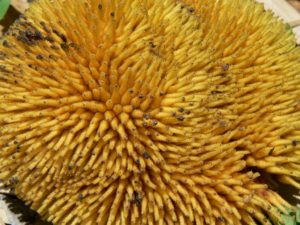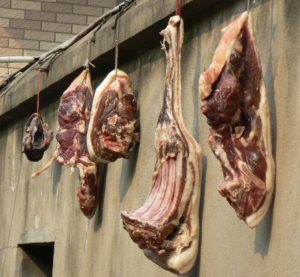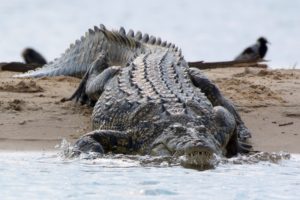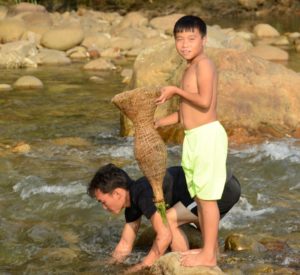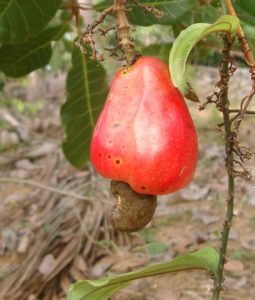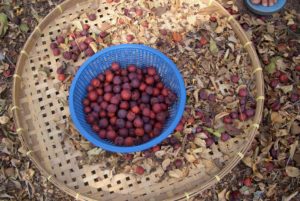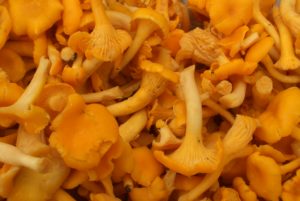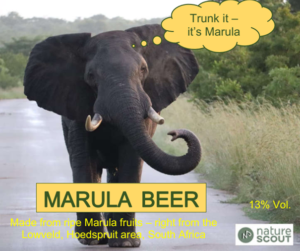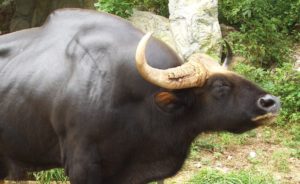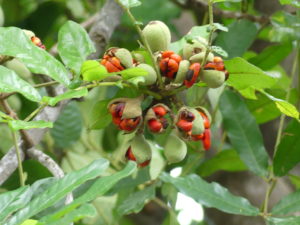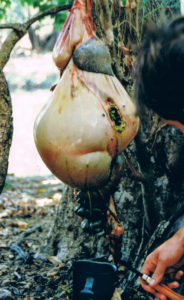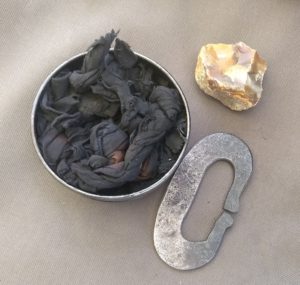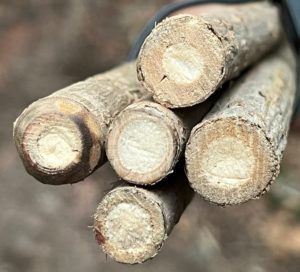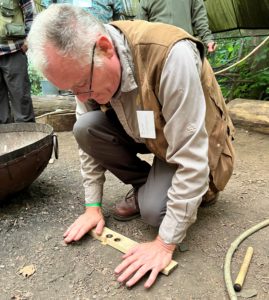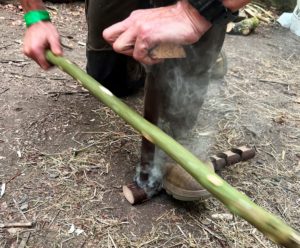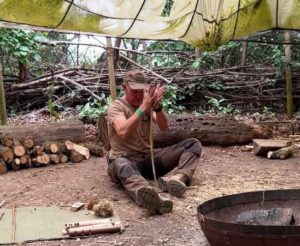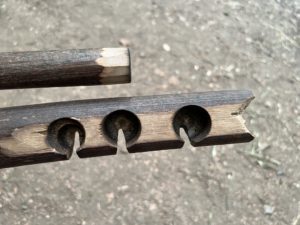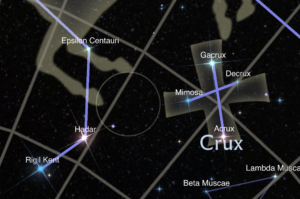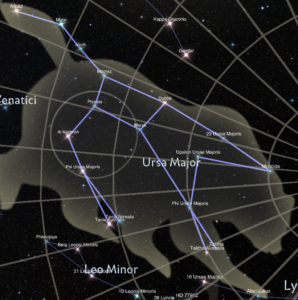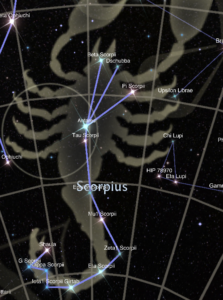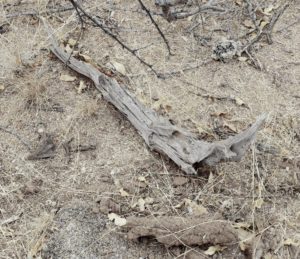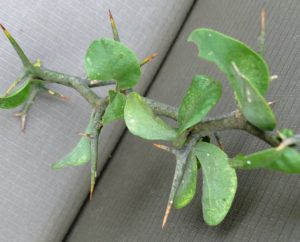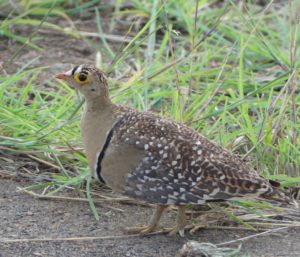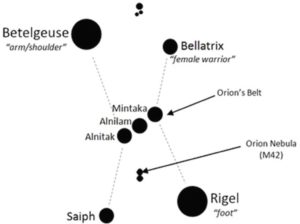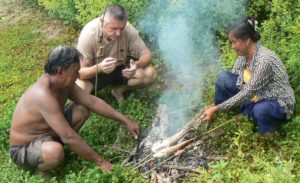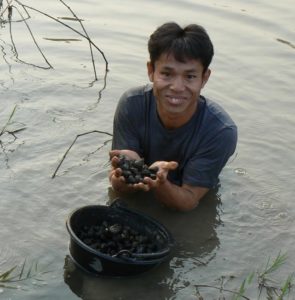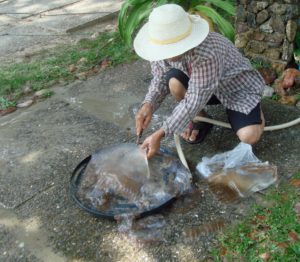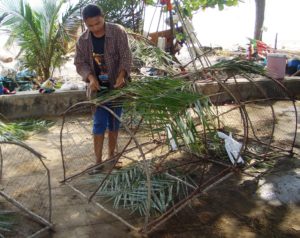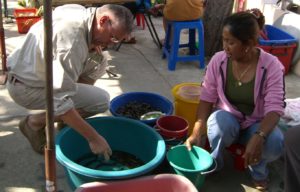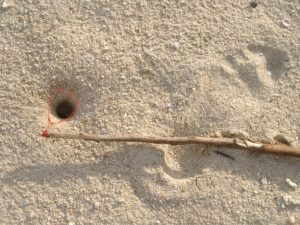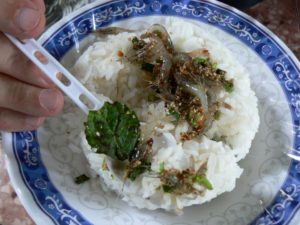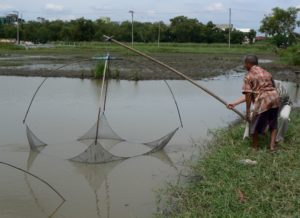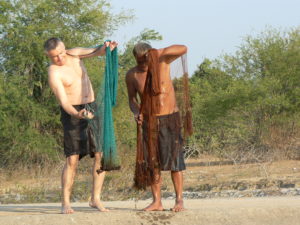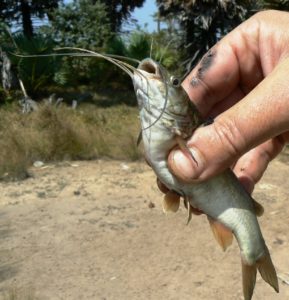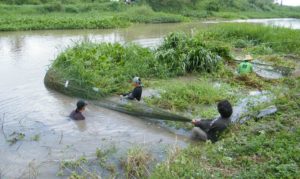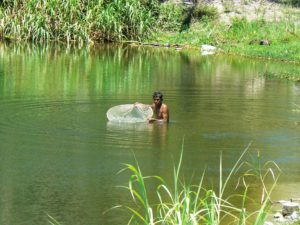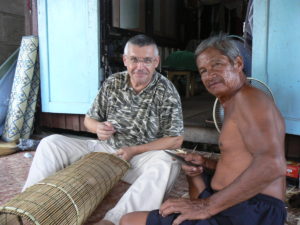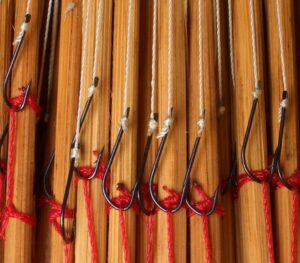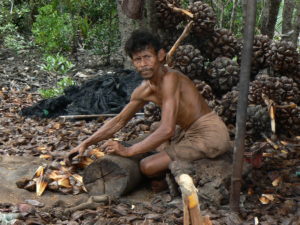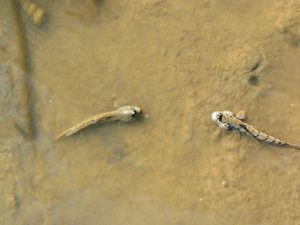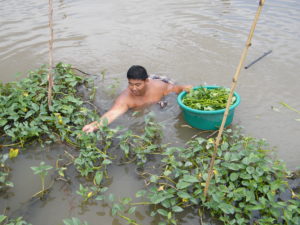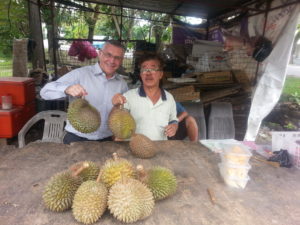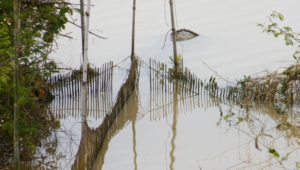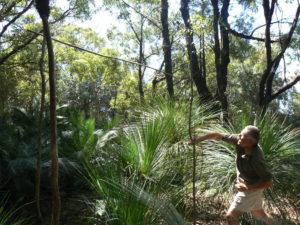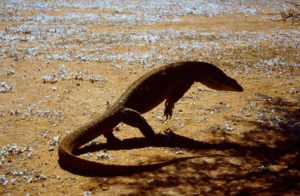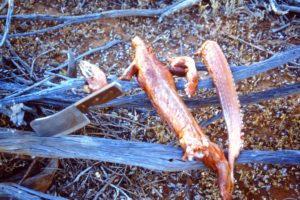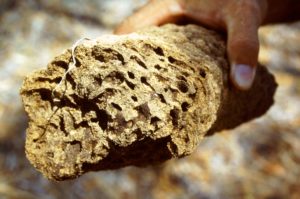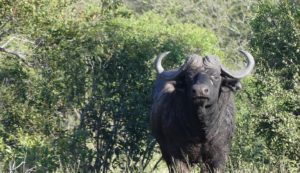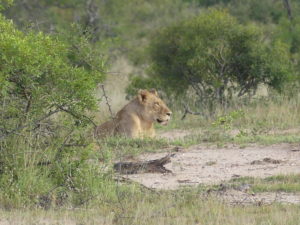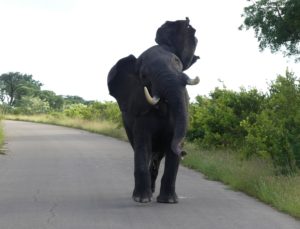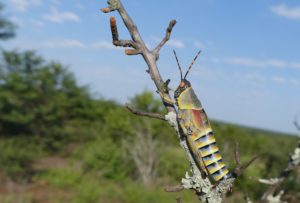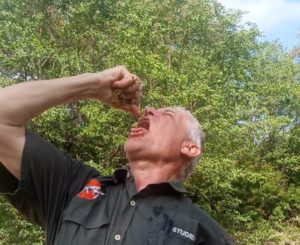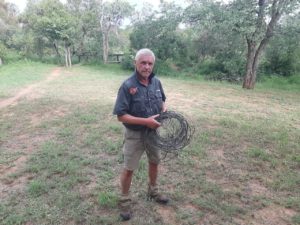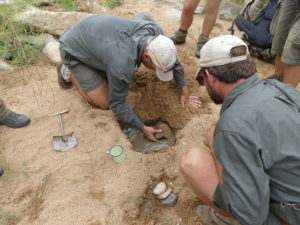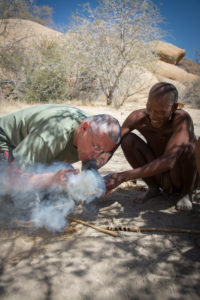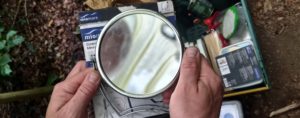Kurt Hoelzl
Marang fruits in Southeast-Asian Rainforests
There are several local names for the tree and fruits of Artocarpus odoratissimus. In English, it is simply called ‘Marang’, which is based on the Philippines’ common name for this fruit. Originally endemic to the region around Mindanao, Sarawak, Kalimantan,…
Drying meat in Shanghai at wintertime
It is at least a 2000-year-old tradition in many provinces in China to cure and preserve meat in wintertime. Pigs were slaughtered after the ‘Light Snowfall’ date (around Nov 22nd/23rd). Then, the temperatures plummeted, and this meat had to be…
Termite mounds indicating direction North
In Southern Africa, fungus-growing termites, which build enclosed mounds without visible ventilation holes, belong to the genera macrotermes. These macrotermes mounds can be up to 6 meters high above ground. The tip nearly always leans slightly over, and the termite…
Danger posed by Nile crocodiles
In the following, Nile crocodiles (Crocodylus niloticus) are called just crocodiles or ‘crocs’. They occur in Southern- and Eastern African regions and along the Atlantic coastline in Central Africa. They eat any animal they can get a hold of and…
Fish ripping in Hanoi, Vietnam
A typical fishing technique in Vietnam is ripping a weighted hook with multiple side arms through still water and hoping to hook unsuspecting fish somewhere on their body. Hooking a fish at the lips with the correct size and style…
Fish trapping at a fast-flowing brook in Vietnam
Trapping fish in bamboo traps in Southeast Asia is normally a static affair. These fishing traps are used in still waters with or without bait inside and checked at least once daily. It was a new experience to see somebody…
Cashew apples and -nuts in Goa, India
Cashew trees (Anacardium occidentale) are native to areas around Northeastern Brazil. Portuguese colonists brought them around 1560 to Goa, India, from where they spread to Southeast Asia and Africa. Therefore, cashew products already have a long history in Goa and…
Jujube trees at Ayutthaya in Thailand
The Ayutthaya Historical Park covers the ruins of the old city, which was founded by the Khmer in 850 AD and named after the Hindu holy city of Ajodhya. The city was destroyed by the Burmese in 1767 and has…
Cormorant fishing at Li Jiang River in China
Cormorant fishing is an ancient art that dates back at least 1300 years. Today, it is only practiced in the southwestern provinces of China. However, some fishermen are attempting to revive this fishing technique for tourists in water villages around…
Chanterelle mushrooms in Thailand
Thai chanterelles, specifically Cantharellus minor, live in symbiosis with Gurjun trees (Dipterocarpus tuberculatus) in semi-deciduous Southeast-Asian forests. These trees are easily identified due to their double-winged (di-ptero) fruits with big seeds. Besides Cantharellus minor, other species of chanterelle mushrooms are…
First shelter of Henno Martin at Kuiseb Canyon
Two German geologists, Dr. Henno Martin and Dr. Herman Korn, went into hiding around the Kuiseb Canyon area, Namibia, for 2.5 years at the beginning of WW2 in 1940 to avoid internment by the South African Union government. During that…
Trunk it – it’s Marula beer!
Marula season in Southern Africa typically occurs in February of each year. When Marulas (Sclerocarya birrea) get ripe, they turn from green to yellow and fall from the female Marula trees. On the ground, they ripen fully and will start…
Taste of Gaur meat at Kaeng Krachan rainforest
We were on a weeklong trail through the Kaeng Krachan rainforest, near Hua Hin in Thailand, when we tasted Gaur meat. Together with two National Park (NP) rangers, we came across a freshly died Gaur heifer. This Gaur (Bos gaurus)…
Natal Mahogany seed milk and its preparation
Natal Mahogany (Trichilia emetica) trees have got a dense canopy of dark green, glossy leaves, and a round outer shape of the tree silhouette. They preferably grow in moist places and riparian forests along drainage lines. Natal Mahogany is easy…
Buffalo thorn tree – an icon in Southern Africa
The Buffalo thorn tree (Ziziphus mucronata) is called in Afrikaans “Blinkblaar-wag-‘n-bietjie” for its shiny leaves and two thorns, which hold people back when getting caught by them. The shrub or tree has got distinctive zigzag branchlets with pairs of two…
Rumen fluid as an emergency drinking liquid
Rumen fluid is a greenish-colored liquid substance with an aromatic and slightly sour smell. It is uniformly distributed in the rumen of antelopes and mixed with grazing or browsing roughage, fermentation gases, and bioactive organisms. The rumen liquid primarily comprises…
Bushscout UK’s fire bundle basket
Terry Longhurst said, “Bundle baskets are what we use with young people when fire lighting. Using a bundle prevents them from getting burnt, and it also helps if they have special needs.” Such a fire bundle basket is chicken wire,…
Fire lighting with Flint & Steel
In the Stone Age and Bronze Age, European men created fire by striking flintstone on marcasite and catching sparks on tinder made from horseshoe fungi. Marcasite is crystallized pyrite (an iron sulfate mineral) and is not readily available but has…
Hand drilling in UK as taught by Dave Watson
Friction fire hand drills are usually not the first choice for fire lighting in the Northern Hemisphere, as they are regarded as a strenuous technique, especially in cold and humid environments. Dave Watson proved this perception is incorrect under overcast…
Bow drill standard procedure by Dave Watson
The approach to friction fire lighting with bow drills in the UK slightly differs from that in other countries. In the following, these differences will be explained. Materials and shapes of the various bow drill elements Hearth board of the…
Bow drilling in Australia by Gordon Dedman
At the Global Bushcraft Symposium 2022 in the UK, Gordon Dedman presented the bow drilling technique he teaches in Australia. Since readers are assumed to know the basics of bow drill friction fire lighting, I will only concentrate on specific…
Hand drill friction fire lighting in Australia
At the Global Bushcraft Symposium 2022 in the UK, Gordon Dedman presented the hand drill friction fire lighting method he teaches in Australia. As most readers of this topic will know the basic techniques of hand drill friction fire lighting,…
Australian friction-fire woods
At the Global Bushcraft Symposium 2022 in the UK, Gordon Dedman presented a variety of types of Australian friction-fire wood, which are well suited for friction-fire lighting methods and tinder. The signature friction-fire method, exclusively used for thousands of years…
Finding True South in the Southern Hemisphere
The Southern Cross, or the Constellation of Crux – as the name implies – is visible in the Southern Hemisphere. It consists of the Southern Cross and the two pointers: Alpha-(Rigil Kent) and Beta-Centauri (Hadar). Finding direction in True South…
Finding direction with the Pole Star
Finding the Pole Star with the Constellation of Ursa Major Only in the Northern Hemisphere is the Pole Star visible, and its location is mainly indicated by the position of the two pointers of the Great Bear (also called the…
Constellation Scorpius at the Southern sky
The Constellation of Scorpius (‘Scorpio’) is a vast constellation visible from May to November in the evening sky of the Southern Hemisphere. It is located directly opposite the Constellation of Orion – therefore, visible when Orion is not. Finding direction…
Firewood from Red Bushwillows is excellent
In Southern Africa, fourteen species of Bushwillows belong to the Combretum family. Other trees of the same Combretum family are Clusterleaf species, Leadwood, and others. Interestingly, not all Combretum species are suitable for firewood, but some are excellent for that…
Greenthorn tree and its uses
The Greenthorn tree (Balanites Maugham) is easily recognizable in Southern Africa due to its triangular, fluted, or buttressed trunk. Its spines are green like its twigs and often forked. It is very spiny and challenging to climb. It mainly grows…
Double-banded Sandgrouse as water indicator
The Double-banded Sandgrouse (Pterocles bicinctus) is commonly and colloquially called by its abbreviation ‘DBSG’ in Southern Africa. Its main distribution area is the savanna biome, especially Mopani Bushveld. There are three more species of sandgrouses in Southern Africa, all having…
Finding direction with the Constellation of Orion
The Constellation of Orion, or ‘The Hunter’ can be best viewed in the evening skies from November to February. It holds for both the Northern and Southern hemispheres during that time. Of the three belt stars, the highest one is…
Spit roasted small and mid-sized fish in Thailand
Grill spit for small fish outdoor cooking on a spit Smaller fish up to about 20 cm long are typically put on a grill spit, which is just a split stick. Often, in Thailand, this will be Pla Kod (Thai:…
Freshwater snails for food
In Thailand, two types of freshwater snails are commonly consumed. The first group is comprised of the larger Apple snails (Pomacea canaliculata), while the other group is referred to as Freshwater snails (Sinotaia sp. & Filopaludina sp.). These genera can…
Jellyfish for food and its preparation
Edible jellyfish (Aurelia sp.) is called ‘Maeng krapun jarn’ (Gulf of Siam) or ‘Lodchong’ (Andaman Sea) in Thailand. Usually, there are about three months a year when jellyfish appear for food. During this jellyfish run, sea fishermen earn a sizeable…
Semi-circular squid traps in Thailand
Squid is a main source of income for many fishermen in villages around the Gulf of Thailand and the Andaman Sea. Because fish are becoming increasingly rare, whereas Cephalopods maintain their population. Only certain types of finfish are sold profitably,…
Catching and holding live eels
The Asian swamp eel (Monopterus albus), called Pla Lai in Thailand, is used as a food source and for offering to the spirit deities. When still slim and young, eels are sold to the Buddhist local population for doing a…
Crab snare at Koh Samui
Simple crab snare for use on a tropical beach A crab snare is usually shaped like a bait cage with about six snares around it. This set-up combines a fishing line and rod or just hung down the sea bottom…
Ricefield shrimps for food
Freshwater prawns (Macrobrachium lanchesteri), also called ‘Ricefield shrimps’ or ‘Goong foi’ in Thai, live in significant numbers in every permanent water body in Thailand. They are the primary food source for various fish and other predators, one of them being…
Hand lifting net (Yor lek) in Thailand
Small lift net for catching daily meals of freshwater prawns and fish ‘Yor lek’ is a hand-lifting net; in Thai, it means something like a ‘small lift net. ‘ ‘Yor’ means ‘lift net’ and ‘lek’ means ‘small’. Its big brothers…
Cast net throwing technique
Description of cast nets used in Thailand Cast nets in Thailand are available in different radius models. I prefer one with a radius of 3.5 meters, which is from the center of the net to the outer axial rim chain,…
Small catfish got dangerous spines in Thailand
There is a variety of small catfish species with dangerous spines living in Thai waters. One, a very abundant one, is locally called Pla Kod (Hemibagrus wyckioides); English common name: Asian Redtail Catfish; Thai name: ปลากด. The typical length for…
Circumferencing water plants to catch fish
Most Thai water channels, khlongs, and streams are clogged with a variety of water plants, predominantly Common Water Hyacinth (Eichhornia crassipes). This invasive species was introduced in 1901 by Thai Royalty from Indonesia and was supposed to be eradicated by…
Hand net fishing
Hand nets, equipment, and technique For hand net fishing, mosquito netting is used to sieve water bodies for rice field shrimps and fish fry in Thailand. In order not to lose caught animals, the netting was brought into a deep,…
Crafting a bamboo fish trap in Thailand
Learning the craft of bamboo fish trap weaving The correct English wording for a ‘Lop’ in Thai would be ‘Horizontal cylinder trap with entry cone’. It is used to catch various freshwater fish and crustaceans, including small snakeheads, catfish, shrimp,…
Bank line fishing in Southeast Asia
The term ‘Bank line’ used in English to refer to a string of poles along a water bank is virtually unknown in Southeast Asia. Instead, this fishing method and its equipment are referred to by different names in the region….
Razor clams collection with quicklime
A mudflat full of razor clams ‘Don Hoi Lot’ is a mudflat in the Thai Province of Samut Songkhram with a size of about 15 km2 (about 9 square miles). ‘Don’ means ‘mudflat’ in English. ‘Hoi’ means ‘clam’, and ‘Hoi…
Harvesting and opening Nipa Palm fruits
Nipa palms (Nypa fruticans) are a species of palms especially adapted to muddy environments of slow-moving tidal waters and mangrove forests. They occur in Asia-Pacific tropical climates. Nipa palm fruits are delicious to eat. Both the fruits and wooden parts…
Mudskippers for food
In Thailand, four mudskipper species can be found. These are the Giant mudskipper (Periophthalmodon schlosseri), Blue-spotted mudskipper (Boleophthalmus boddarti), Gold-spotted mudskipper (Periophthalmus chrysospilos) and the Indian Dwarf mudskipper (Periophthalmus novemradiatus). The Giant- and Blue-spotted mudskippers live at the Andaman Sea-…
Morning glory – a valuable wild vegetable in Asia
Swamp morning glory or Water spinach (Ipomoea aquatica) has various common names, like ‘Kangkong’ in Southeast Asia or ‘Kung Shin Tsai’ in China. It is a staple vegetable food throughout the Asia-Pacific region. It is deficient in calories (19 cal/100…
Heavenly Durian
The fruit Durian (Durio zibethinus) is named after the Malay word ‘Duri’ for ‘Thorn’, referring to the thorny skin, and ‘zibethinus’ obviously refers to its smell. And the most sought-after variety in Malaysia is ‘Musang King’, where ‘Musang’ means ‘Palm…
Bamboo fence fish traps around Tonlé Sap lake
In many areas of the biggest Cambodian lake, its tributary river, and the Mekong flood plains, permanent bamboo fence fish traps, or, more appropriately, catching structures, are erected and operated. The leader fence, which guides fish into the trap’s inner…
Spear shafts from grass tree stalks
Grass trees (Xanthorrhoea sp.) and grass tree stalks are endemic to Australia. They are locally called ‘Black Boys’ due to their appearance after bushfires. They need a certain number of regular fires for their survival and are well protected against…
Spinifex grass – friend and foe
The common name ‘Spinifex grass’ is not entirely correct as a botanical term for discussed grasses, as commonly named ‘Spinifex’ grasses belong to the genus ‘Triodia’, whereas the genus ‘Spinifex’ itself contains mainly coastal grasses. Whatever it is, the common…
Spotting a magnificent sand monitor (Goanna)
Description of Goannas The Australian sand monitor (Varanus gouldii) is also called Gould’s monitor or colloquially ‘Goanna’. There are two subspecies: Varanus gouldii gouldii and Varanus gouldii flavirufus (smaller subspecies). V. gouldii gouldii is distributed nearly all over Australia except…
Eating a sand monitor lizard (Goanna)
In the former article, I described seeing a majestic sand monitor lizard close by on my drive from Menzies to Sandstone on a side road. Driving further on, I was surprised to see many more Goannas left and right on…
Ant beds for building materials in Australia
Although they are commonly referred to as “Ant beds,” particularly in Australia, the structures are actually “Termite mound.” Despite their physical similarities to ants, termites are related to cockroaches rather than ants. However, like ants, they are small and numerous….
African buffalos are dangerous
Danger of buffaloes is overrated. The ‘Cape buffalo’ (Syncerus caffer caffer) as a subspecies of the ‘African buffalo’ (Syncerus caffer) is the typical Southern African savannah biome buffalo species. The denomination of ‘African Black Death’ was coined by trophy hunters,…
Lion behavior – so different by day and night
The general behavior of lions African Lions (Panthera leo) are sometimes overrated in their danger for people hiking in Big-5 game areas. Lion behavior is such that they usually sleep and rest for 20 hours a day to replenish their…
Recipe for disaster – elephant bulls in musth
Musth is a condition of elevated testosterone levels in the blood of elephants. African elephant (Loxodonta africana) bulls come into their first musth when they are between 15 – 17 years old. The length of the musth depends on the…
Spekboom leaves as vegetable in South Africa
Among the many edible South African plants, few are as remarkable as Spekboom (Portulacaria afra), a member of the Didiereaceae family. Known locally as the elephant bush, this hardy succulent is celebrated for its ecological benefits and, increasingly, for its…
Poisonous beauty: The ‘Elegant Grasshopper’
Aposematic coloration The ‘Elegant Grasshopper’ (Zonocerus elegans) occurs commonly throughout Southern Africa and is mentioned due to its aposematic coloration, typical for animals that want to announce that they are poisonous. And he is a poisonous grasshopper. In the case…
Water from elephant dung
Elephants are a kind of dung-producing machines In the wild, African elephants (Loxodonta africana) are foraging about 150 – 180 kg of plant material per day. And they also drink about 350 liters of water. Consequently, they excrete about 10 –…
Snares for poaching are a real problem
Many national parks, private game reserves, and game farms in Southern Africa are under heavy pressure from snares for poaching—not only rhino horn poaching but also indiscriminate poaching for meat. Internationally acting gangs from certain countries mainly organize rhino horn…
Digging for water by wells in sandy riverbeds
Where to dig One of the most essential techniques for finding drinkable water in Southern African natural environments is digging for water in areas that are holding water underground. These water-holding structures can be situated next to an open water…
Creating fire by hand drill in Namibia
The type of wood for fire hand drills changed over time Fire starting with friction hand drills was traditionally common among Khoi-san (Ju//hoansi) people in their distribution area, which was once over Southern Africa and became increasingly confined by invading…
Solar fire lighting
The energy received by the earth from the sun is called the Solar Constant, which describes the effect that every 1 m2 of planet Earth facing the sun’s rays at a 90-degree angle (directly overhead) will receive 1375 Watts (Joules/sec)….

